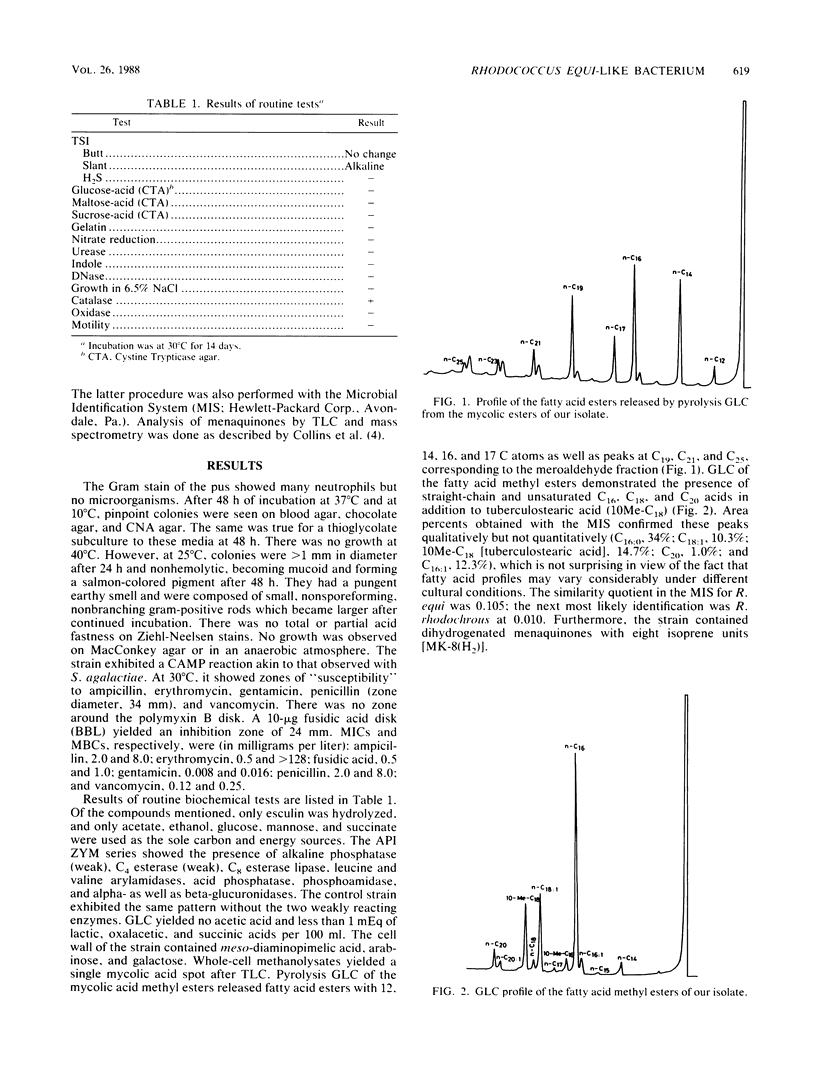Abstract
A case of superficial wound infection in a noncompromised host due to a Rhodococcus equi-like organism, acquired from soil, is described. The strain grew poorly at 37 degrees C and showed several differences from wild-type R. equi in biochemical tests and in its fatty acid and mycolic acid compositions.
Full text
PDF


Selected References
These references are in PubMed. This may not be the complete list of references from this article.
- Barton M. D., Hughes K. L. Ecology of Rhodococcus equi. Vet Microbiol. 1984 Feb;9(1):65–76. doi: 10.1016/0378-1135(84)90079-8. [DOI] [PubMed] [Google Scholar]
- Broughton R. A., Wilson H. D., Goodman N. L., Hedrick J. A. Septic Arthritis and osteomyelitis caused by an organism of the genus Rhodococcus. J Clin Microbiol. 1981 Jan;13(1):209–213. doi: 10.1128/jcm.13.1.209-213.1981. [DOI] [PMC free article] [PubMed] [Google Scholar]
- Bürger H., Müller H. E. Rhodococcus isoliert aus Glutäalabszess. Infection. 1982 Nov-Dec;10(6):343–346. doi: 10.1007/BF01642296. [DOI] [PubMed] [Google Scholar]
- Collins M. D., Pirouz T., Goodfellow M., Minnikin D. E. Distribution of menaquinones in actinomycetes and corynebacteria. J Gen Microbiol. 1977 Jun;100(2):221–230. doi: 10.1099/00221287-100-2-221. [DOI] [PubMed] [Google Scholar]
- FRASER G. THE EFFECT ON ANIMAL ERYTHROCYTES OF COMBINATIONS OF DIFFUSIBLE SUBSTANCES PRODUCED BY BACTERIA. J Pathol Bacteriol. 1964 Jul;88:43–53. doi: 10.1002/path.1700880105. [DOI] [PubMed] [Google Scholar]
- Goodfellow M., Beckham A. R., Barton M. D. Numerical classification of Rhodococcus equi and related actinomycetes. J Appl Bacteriol. 1982 Oct;53(2):199–207. doi: 10.1111/j.1365-2672.1982.tb04677.x. [DOI] [PubMed] [Google Scholar]
- Reddy C. A., Kao M. Value of acid metabolic products in identification of certain corynebacteria. J Clin Microbiol. 1978 May;7(5):428–433. doi: 10.1128/jcm.7.5.428-433.1978. [DOI] [PMC free article] [PubMed] [Google Scholar]
- Severo L. C., Petrillo V. F., Coutinho L. M. Actinomycetoma caused by Rhodococcus spp. Mycopathologia. 1987 Jun;98(3):129–131. doi: 10.1007/BF00437647. [DOI] [PubMed] [Google Scholar]
- Thomsen F., Henriques R., Magnusson M. Corynebacterium equi Magnusson isolated from a tuberculoid lesion in a child with adenitis colli. Dan Med Bull. 1968 May;15(5):135–138. [PubMed] [Google Scholar]
- Traub W. H., Kleber I. Interpretation of diffusion susceptibility data obtained with 10-mug fucidin (sodium fusidate) disks against clinical isolates of Staphylococcus aureus. Chemotherapy. 1974;20(2):92–96. doi: 10.1159/000221796. [DOI] [PubMed] [Google Scholar]
- Van Etta L. L., Filice G. A., Ferguson R. M., Gerding D. N. Corynebacterium equi: a review of 12 cases of human infection. Rev Infect Dis. 1983 Nov-Dec;5(6):1012–1018. doi: 10.1093/clinids/5.6.1012. [DOI] [PubMed] [Google Scholar]


